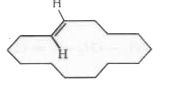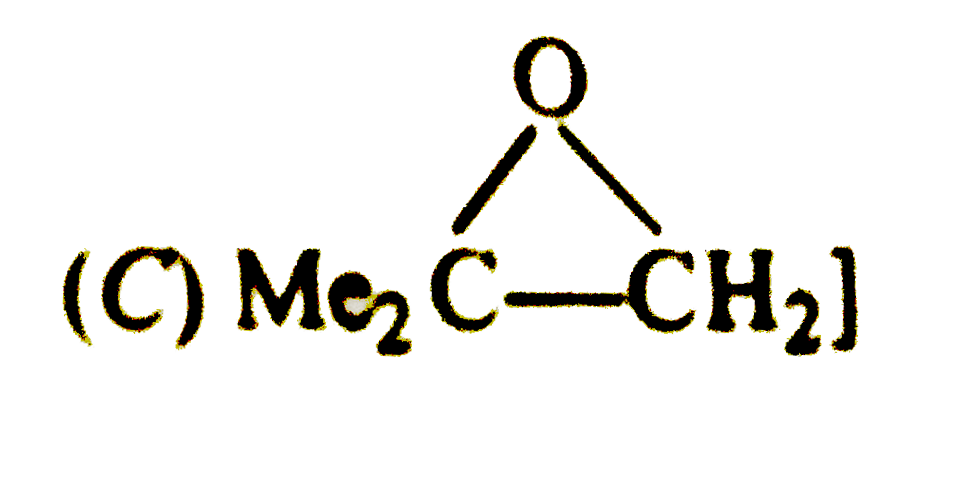Ph−CH∣Cl−CH2−Cl(i)Alc.kOH−−−−−−−−−−→(ii)NaNH2(iii)H+ACold alk.KMnO4−−−−−−−−−→BNaOH−−−−−→warmC
The product 'C' eill be
Ph−OH∣CH−COO
Ph−C∣OHH−C∣OHH2
Ph−CH2−COO−
Ph−O∣∣C−C∣OHH2
The correct Answer is:A
To solve the given question step by step, we will analyze the reactions and transformations that occur to the starting compound through the specified reagents.
Step 1: Identify the Starting Compound
The starting compound is a phenyl group connected to a carbon chain with a chlorine atom (Cl) attached to it. The structure can be represented as:
Ph-CH(CH2-Cl)
Step 2: Treatment with Alcoholic KOH or NaNH2
When the compound is treated with alcoholic KOH or sodamide (NaNH2), both act as dehydrohalogenating agents. They will remove a hydrogen atom and a chlorine atom, resulting in the formation of a double bond.
The reaction can be summarized as:
Ph-CH(CH2-Cl)alc. KOH or NaNH2−−−−−−−−−−−−→Ph-CH=CH-Cl+HCl
Step 3: Forming Product A
After the elimination of HCl, we obtain product A:
A: Ph-CH=CH-Cl
Step 4: Treatment with Cold Alkaline KMnO4
Next, product A is treated with cold alkaline KMnO4, which is known as Baeyer's reagent. This reagent adds hydroxyl (OH) groups across the double bond.
The reaction can be represented as:
Ph-CH=CH-Clcold KMnO4−−−−−−−→Ph-CH(OH)-CH(OH)-Cl
Step 5: Forming Product B
After the reaction with KMnO4, we get product B:
B: Ph-CH(OH)-CH(OH)-Cl
Step 6: Treatment with Warm NaOH
Finally, product B is treated with warm sodium hydroxide (NaOH). The strong base will facilitate the substitution reaction, leading to the formation of a carboxylic acid.
The reaction can be summarized as:
Ph-CH(OH)-CH(OH)-Clwarm NaOH−−−−−−−→Ph-COOH+NaCl+H2O
Step 7: Forming Product C
After the reaction with warm NaOH, we obtain product C:
C: Ph-COOH
Final Answer
The product 'C' will be:
C: Ph-COOH (benzoic acid)
---
The starting compound is a phenyl group connected to a carbon chain with a chlorine atom (Cl) attached to it. The structure can be represented as:
Ph-CH(CH2-Cl)
When the compound is treated with alcoholic KOH or sodamide (NaNH2), both act as dehydrohalogenating agents. They will remove a hydrogen atom and a chlorine atom, resulting in the formation of a double bond.
Ph-CH(CH2-Cl)alc. KOH or NaNH2−−−−−−−−−−−−→Ph-CH=CH-Cl+HCl
After the elimination of HCl, we obtain product A:
A: Ph-CH=CH-Cl
Next, product A is treated with cold alkaline KMnO4, which is known as Baeyer's reagent. This reagent adds hydroxyl (OH) groups across the double bond.
Ph-CH=CH-Clcold KMnO4−−−−−−−→Ph-CH(OH)-CH(OH)-Cl
After the reaction with KMnO4, we get product B:
B: Ph-CH(OH)-CH(OH)-Cl
Finally, product B is treated with warm sodium hydroxide (NaOH). The strong base will facilitate the substitution reaction, leading to the formation of a carboxylic acid.
Ph-CH(OH)-CH(OH)-Clwarm NaOH−−−−−−−→Ph-COOH+NaCl+H2O
After the reaction with warm NaOH, we obtain product C:
C: Ph-COOH
The product 'C' will be:
C: Ph-COOH (benzoic acid)
Similar Questions
Knowledge Check
- Question 1 - Select One
 Br2−−→CCl4(i)alc. KOH−−−−−−−→(ii)NaNH2(A)major, Product (A) is :AH2C=CH−CH=CH2BCH3−C≡C−CH3CCH3−CH2−C≡CHDCH3−CH=C=CH2
Br2−−→CCl4(i)alc. KOH−−−−−−−→(ii)NaNH2(A)major, Product (A) is :AH2C=CH−CH=CH2BCH3−C≡C−CH3CCH3−CH2−C≡CHDCH3−CH=C=CH2 - Question 2 - Select One
Br−(CH2)12−C≡CHNaNH2−−−−→(A)Lindlar−−−−→Catalyst(B), Product (B) is
A B
B C
C DBr−(CH2)−CH=CH2
DBr−(CH2)−CH=CH2 - Question 3 - Select One
Ph−Cl∣C∣Cl−CH33NaNH2−−−−→(A)Product, product (A) is :
APh−CH=CH2BPh−C≡CHCPh−CH2−CH3DPh−C≡ɵC⊕Na
 (B)2mol−−−−−−→Cl2+hv (C)2mol−−−−−−−−→Alc.KOH
(B)2mol−−−−−−→Cl2+hv (C)2mol−−−−−−−−→Alc.KOH
(D) CH2=CH2−−−−−−−→Δ (E)
The final product (E) is :View SolutionCH3−CH3∣C∣CH3−O−CH2−CH3Cold and conc.−−−−−−−−→HI?
The product isView Solution(A)Alc.KOH−−−−−→CH3−CH=CH2HBr−−−−−−→(Peroxide)(B) Find the product (A) and (B) in the given reaction
View SolutionPh−Ph∣C∣OH−H∣C∣OH−HΘ−−→XMajor identify X.
View SolutionSupply structural formulae for missing compounds.
(i) H2C=CH2+(A)→ClCH2−CH2OHH2SO4−−−−−−→413K(B)alc. KOH−−−−−−−→Δ(C)
(ii) CH3CHBrCH3alc. KOH−−−−→(A)HBr−−−−−→Peroxide(B)CH3ONa−−−−−→(C)
(iii) Me3CBralc. KOH−−−−→(A)HOCl−−−→(B)NaOH−−−→(C)
 View Solution
View Solution

